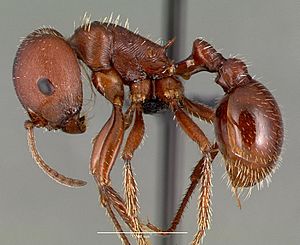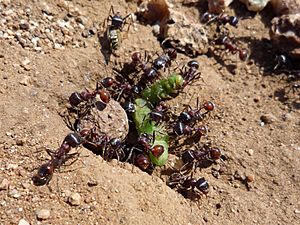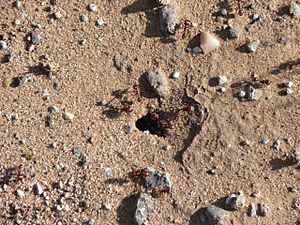Red harvester ant facts for kids
Quick facts for kids Pogonomyrmex barbatus |
|
|---|---|
 |
|
| P. barbatus worker from Texas, United States | |
| Scientific classification |
The red harvester ant (scientific name: Pogonomyrmex barbatus) is a type of harvester ant. People also call it the red ant. These ants are quite big, about 5 to 7 millimeters long. They like dry areas like chaparral and live in the Southwestern United States. They build their nests underground, sometimes as deep as 2.5 meters.
Red harvester ants mainly eat seeds. They help plants by spreading their seeds around, a process called myrmecochory. This helps both the ants (who get food) and the plants (whose seeds get moved to new places). Red harvester ants are often confused with fire ants, but they are not closely related.
Contents
Ant Homes: How They Build Nests
Red harvester ant nests are easy to spot. They usually have no plants growing around them. You might see small pebbles near the entrance to their tunnel. This tunnel usually goes down into the ground at a sharp angle. You might also find empty seed shells scattered around the nest. In grassy areas, like ranches, these bare spots make the ant colonies very easy to see. If there are many colonies, they can reduce the amount of grass available for animals to eat.
The ant mounds are usually flat and wide. They are about 0 to 100 millimeters (0 to 4 inches) high. They can be 300 to 1200 millimeters (1 to 4 feet) wide. Some areas cleared by ants have been reported to be as large as 10 square meters (100 square feet).
About three to eight trails usually lead away from the mound, like "arms." Ants use these trails to collect food and bring it back to the nest. "Scout" ants are the first ones out each morning. They look for food. When they find it, they leave a scent trail as they return to tell the worker ants. The worker ants follow this scent trail to collect the food. Other worker ants clean and expand the mound. They also take care of the queen and the young ants, called the brood. All the ants in the colony are female, except for the winged males that are born during the breeding season.
Starting a New Colony
An ant colony is like a family unit. A single queen ant first mates with several males. This happens at a special meeting place where male harvester ants gather. After mating, she flies to a new spot to start her own colony.
What Red Harvester Ants Eat
The main food for red harvester ants is seeds. They collect and store huge amounts of seeds. First, they grind the seeds into a bread-like food using their large mandibles (jaws). Then, they store this food in a special storage area called a granary. This way, the colony has food all year long.
When red harvester ants collect seeds, they help their environment. This is through a process called myrmecochory. The ants help spread seeds while they are looking for food. Both plants and ants benefit from this. Plants get their seeds spread over a wider area. Ants get food and a more reliable food supply in the future. This is a type of mutualistic interaction, where both sides benefit. They also collect dead insects when they are out foraging.
How Ants Find Food (Foraging)
Scientists have studied a lot about how red harvester ants find food. Three main types of worker ants help with foraging. These are nest patrollers, trail patrollers, and foragers.
Each day, nest patrollers come out first. They check if it's safe and worth it to go out and find food. Ants get most of their water from the fats in seeds. If there isn't much food, or if it's a very hot day, finding food might use up too much energy and water. In these cases, the colony might use its stored food instead. Seeds can be stored in the nest for months or even years.
Ants communicate by touching each other with their antennae. They pass along chemical signals. They also use other clues like what they see, how much time passes, and smells. Based on what the nest patrollers report, trail patrollers might leave the nest. They figure out the best direction to find food. This decision depends on things like how much food is available and what other nearby ant nests are doing.
When both types of patrollers return, the foragers watch how quickly they come back. This helps them decide whether to leave the nest to find food. If patrollers return quickly, it means there's lots of food and good conditions. This makes it worth it for foragers to go out. If patrollers return too quickly, it might be a warning of danger, like a lizard nearby. If they return too slowly, it could mean there's not enough food or too much competition.
Ants use chemical signals to guide them. They can travel up to 50–60 meters (164–197 feet) from the nest. Once an ant decides to forage, it almost always keeps going until it finds food. About 90% of ants that go out come back with food. So, how quickly foragers return is a good sign of how much food is available. When there's plenty of food, foragers find it fast and return quickly. Ants still in the nest see this and know that finding food will be easy. This makes more ants go out to forage. If less food is available, foragers return slower. This makes the colony reduce its foraging activity.
It's very important for a colony to quickly change how it forages. This is because their food source can change and is spread out. This ability to change is also affected by how much food is available, how much the colony needs to eat, and how healthy the colony is. Red harvester ants are very good at working together, weighing costs and benefits, and making smart decisions as a group.
Working Together to Find Food
Harvester ant colonies work without a single leader. They use chemical signals to communicate. Foraging is controlled by positive and negative feedback. When ants return to the colony with seeds, it encourages more ants to go out. When fewer ants return with seeds, fewer ants go out. This helps them find food based on how much is available. This communication between returning and outgoing ants happens very quickly, in just a few seconds.
Ants figure out how much food is available by how long it takes to find each seed, not how far they travel. When food is plentiful, foragers take less time. Faster foraging signals mean more ants go out, helping them collect as much food as possible. Seeds are also a source of water for ants. They often keep seeds in the nest for months or even several years.
Competition for Food
Different types of harvester ants compete with each other for food. For example, Novomessor cockerelli ants sometimes try to stop Pogonomyrmex barbatus ants from foraging. They do this by "plugging" the entrances to P. barbatus nests with sand and small rocks. This delays P. barbatus ants for one to three hours. It makes them start foraging later in the day when it's much hotter. This reduces how much food they can collect in two ways. First, they have less time to forage. Second, the hot ground makes them go back into their nests sooner. Studies show that P. barbatus ants don't try to make up for this delay by foraging more. So, nest plugging by rival species really hurts how much work the Pogonomyrmex barbatus ants can do.
Ant Jobs: Division of Labor
Red harvester ants are eusocial insects. This means they have a high level of teamwork and organized jobs. The worker ants cannot have babies. Like most ant species, reproduction is done by special winged ants called alates (reproductives). They stay in the nest until the weather is right for them to fly out and mate. After mating, the male usually dies. The fertilized queen then returns to the ground to find a good place for a new nest. Once she chooses a spot, she breaks off her wings and starts to lay eggs. She creates a new colony. She produces "worker ants" for 1 to 20 years until she dies. Some queens have been known to live up to 30 years in the wild.
In P. barbatus, tasks are divided into a caste system. Some ants are specialized for having babies. Other ants are responsible for non-reproductive jobs. These jobs include defending the nest, caring for the young, and finding food. This system of dividing jobs naturally happens when the group forms. It's not something they learn later. Even queen ants that are forced to live together will start to divide jobs, even if their species didn't always live in groups.
Worker Ant Jobs
Within the worker ants of P. barbatus, there are five main jobs. These are foraging (finding food), maintaining the nest, defending the colony, working on the "midden" (trash pile), and convening (gathering). These roles are not fixed. Chemical signals decide when certain ants do certain activities. So, these jobs are flexible and work together. When one group of ants changes its behavior, it causes other groups to change theirs too.
Queen and Male Ant Jobs
The queen and male ants are responsible for starting new colonies. A single queen ant starts every colony. Many winged male ants and virgin queen ants fly to special mating spots after midsummer monsoon rains. To start a successful colony, P. barbatus queens must mate with males from two different groups. One group of males produces ants that become the workers of the colony. These are the ants that do all the non-reproductive jobs. The other group produces female ants that can also reproduce.
After mating with the male ants, the queen flies away to start a new colony. When she arrives at her new nest site, the queen loses her wings. She then builds a nest in the soil. She seals the entrance to the nest to lay her eggs safely. This is how the colony begins. Over the next six to eight weeks, the first group of worker ants hatches. They then start to find food and build up the colony.
Ant Life Cycle: Reproduction
Mating Behavior
Mating happens all year round and is specific to each type of red harvester ant. Males can tell which females are from their own species by using special chemicals called pheromones. These pheromones are released from the poison glands of the female P. barbatus ants. Male ants can perfectly detect these pheromones when they touch the females.
Mating happens at special gathering places. Male ants first mark these spots with chemicals from their jaw glands. These chemicals attract females and more males. This leads to strong competition among males for mates. The mating system of P. barbatus is similar to lek behavior seen in many vertebrate animals. Male ants gather together and release a pheromone that attracts female ants. The more males present, the stronger the attraction for the females. Even though this system means some males get many mates and others get none, the gathering of males attracts more females overall than a single male trying to attract them alone. So, it's better for less attractive males to stay in the group than to try to attract females by themselves.
Who Eats Red Harvester Ants?
Red harvester ants are a favorite food for desert horned lizards. Harvester ants fiercely defend their colonies from any attacks, whether from large or small animals. They can bite very hard, and their stings are venomous and painful. The venom spreads through the body's lymphatic system. It can sometimes cause dangerous reactions, especially in animals that are sensitive or allergic to their venom.
Over the years, the number of red harvester ants has been going down. This is often blamed on competition for food with other ants that have been brought into the area, like the red imported fire ant and the Argentine ant. Their decline has affected many native animals, especially those that rely on the red harvester ant as a main food source, such as the Texas horned lizard.
See also
 In Spanish: Hormiga cosechadora roja para niños
In Spanish: Hormiga cosechadora roja para niños



